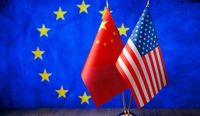As trade tensions escalate between the United States and China, the latter has been compelled to weaken its national currency in an effort to counteract the impact of a staggering 104% tariff imposed by the U.S. on Chinese goods. This significant development marks a new chapter in the ongoing trade war, which shows no signs of abating.
On April 9, 2025, the U.S. officially implemented these tariffs, which could severely affect the flow of goods between the two largest economies in the world. According to experts, in 2024, Chinese businesses exported nearly $3.60 trillion worth of goods and services to the U.S., while importing only $2.69 trillion, resulting in a trade surplus of almost $1 trillion for China. The American market is crucial for China, and this new tariff is set to disrupt a vital economic relationship.
In response to the tariffs, the People's Bank of China set the reference rate of the yuan at 7.2038 per one U.S. dollar on April 8, 2025, marking the lowest value since September 2023. This devaluation is intended to make Chinese products cheaper and more attractive in foreign markets, thereby softening the blow of the new trade duties. As the yuan becomes less valuable, the cost of Chinese goods in dollars decreases, potentially increasing their appeal to international buyers.
Becky Liu, head of macroeconomic strategy at Standard Chartered Bank, commented on the situation, stating, "China allows for greater flexibility in its currency as a tool to ease the pressure on its economy amid aggressive tariff hikes." However, this strategy comes with risks for the average Chinese citizen, who may find their earnings diminished as the currency weakens while the demand for production increases.
Meanwhile, the U.S. is also bracing for the repercussions of this trade war. Economists warn that these tariffs are likely to accelerate inflation, meaning American consumers will face higher prices for everyday goods. The situation has led to a grim outlook on both sides of the Pacific, with uncertainties looming over the future of this economic conflict.
As President Donald Trump threatened to nearly double tariffs on Chinese goods, Beijing responded with a firm stance, vowing to "fight to the end." The White House's announcement of a 104% tariff on goods from China has created an unprecedented scenario where almost all imports from China could be subject to exorbitant taxes. This move is expected to hit a wide range of products, including smartphones, computers, lithium-ion batteries, toys, and gaming consoles.
Alfredo Montufar-Helu, a senior advisor at The Conference Board, warned against any assumptions that China would capitulate easily, stating, "It would be a mistake to think that China will back down and remove tariffs unilaterally." He emphasized that such an action would portray China as weak and provide the U.S. with grounds to escalate the situation further.
The consequences of this trade war extend beyond just tariffs. The global financial markets have already reacted negatively, with many Asian stocks experiencing their most significant declines in decades following Trump's tariff announcements. Although some losses were recouped in subsequent trading sessions, the overall sentiment remains cautious.
China has retaliated by imposing its own tariffs on U.S. goods, initially set at 34%, and has limited the operations of several American companies within its borders. As tensions continue to rise, Trump's administration has warned that if China does not yield, tariffs could increase by another 50%.
In the midst of this turmoil, experts express concern over the rapid pace of developments, which leaves little time for businesses and investors to adapt to the shifting landscape. Mary Lovely, a trade expert at the Peterson Institute, remarked, "We are witnessing a game of who can outlast whom. There is no longer any talk of mutual benefit." She added that despite China's slowing economic growth, it may be prepared to endure hardship rather than capitulate to what it perceives as U.S. aggression.
Andrew Collier, a senior fellow at the Mossavar-Rahmani Center for Business and Government at Harvard Kennedy School, noted that the tariffs exacerbate existing challenges for China, including a struggling real estate market and rising unemployment. He stated, "If Chinese exports suffer, it will hit a crucial revenue stream for the Chinese budget."
In 2024, the U.S. imported $438 billion worth of Chinese goods while exporting only $143 billion to China, resulting in a trade deficit of nearly $300 billion. This imbalance highlights the complexities of the economic relationship between the two nations, which are intricately linked through vast amounts of investment and trade.
Deborah Elms, head of trade policy at the Hinrich Foundation in Singapore, pointed out that the effects of tariffs can be limited, but both sides have numerous ways to inflict economic pain on each other. She stated, "While it may seem that things can't get worse, there are many ways to deepen the crisis further." The global community is closely monitoring how China's export strategies will shift in light of the lost American market, with potential rerouting of goods to Southeast Asia being one possibility.
As the trade war continues to escalate, the future remains uncertain. Roland Raja, a leading economist at the Lowy Institute, remarked that the motivations behind the new tariffs are unclear, making it challenging to predict their long-term impact. He noted that China possesses a wide array of tools for retaliation, including further currency devaluation and restrictions on American companies operating in China.
Despite the tumultuous climate, some analysts believe there may still be room for negotiation behind closed doors. However, skepticism abounds as Trump has yet to engage in direct talks with Chinese President Xi Jinping since returning to office. Elms expressed concern over the rapid escalation of tensions, stating, "I think the U.S. is overreaching. The future looks much heavier, and the risks are quite high."
As both nations navigate this turbulent economic landscape, the world watches closely, waiting to see how this trade war will unfold and what it may mean for global trade dynamics.






